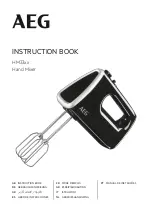
32
Chapter 4
Videonics MX-Pro User Guide
S
TARTING
AND
S
TOPPING
MXP
RO
Press the Power switch to start or stop MXPro. The switch, located on the right-end of
the unit, is a rocker-type switch. Also power on or off all sources and output devices.
U
NDERSTANDING
THE
K
EYBOARD
Use the MXPro keyboard to control how the unit operates. The better you understand
all of the functions available from the keyboard the better your results.
This section briefly describes the button groups and, in some cases, individual buttons
and controls. Additional information appears throughout this User Guide. Some of the
following descriptions provide a reference to the page where you can find details. Refer
to the illustration on the next page while reading this material.
1
T-Bar (or, Take Bar)
— Use to manually control the way transitions run. See
Chapter 5,
Transitions
.
2
Function Buttons
— Provide immediate access to built-in functions, including
DISPLAY
,
SETUP
,
ROUTE
,
LEARN
,
COMPOSE
,
PIPS
,
AUDIO MIX
, and
FREEZE
.
You can also access the built-in demo using these buttons. See Chapter 7,
Func-
tions
, for details.
3
Source Selectors
— Use to select the CURRENT (CUT) and NEXT sources for a pro-
duction. Normally, you select the CURRENT and NEXT sources, select a transition
to use between the two, then run it. For example, you might select a camcorder
as one input source (CURRENT) and a VCR as the other (NEXT). You then select a
transition, such as a dissolve or wipe. When you reach the point in the CURRENT
source where you want to change to the NEXT source, press
PLAY
or use the
T-BAR
to instruct MXPro to play the transition. The CURRENT source becomes
the new NEXT source, and the old NEXT source becomes the new CURRENT
source. (See “Using CURRENT and NEXT Sources” beginning on page 38.) Use the
COLOR buttons to create solid colored backgrounds and other effects. (See
“Working with Colors” beginning on page 42.)
4
Video/Audio Selector
— Determines whether VIDEO, AUDIO, or both VIDEO and
AUDIO are affected when you run a transition. When set to
VIDEO
, the video
changes but the audio does not. When set to
AUDIO
, the audio changes but the
video does not. When set to both, the video and audio both change. See “Using
the Video/Audio Selector” on page 40.
5
Joystick
— Provides an easy way to make fine adjustments to various compo-
nents. For example, when using PIPs the joystick positions the various picture ele-
ments on the screen — when using color correction, use the joystick to adjust the
color. The joystick has other uses you’ll learn about in later chapters.
6
Power Switch and Headphone Jack
— These two components are located on the
right-hand side of the unit, not on the top. The Power Switch is a rocker-type
switch for turning the unit on and off. The Headphone Jack provides a means for
connecting a set of headphones to the unit.
7
Transition Category Buttons
— Gives you immediate access to the five, major
categories of transitions, including
USER
,
BASIC
,
EDGES
,
TRAILING
, and
SHAPES
. All MXPro transitions fall into one of these categories. After pressing a
button, you can search through the transitions in that category to find the one
you want to use. See “Transition Categories and Menus” beginning on page 52.
Содержание MXPro
Страница 1: ...MXPro User Guide...
Страница 4: ...Notes...
Страница 56: ...Notes...
Страница 70: ...Notes...
Страница 78: ...Notes...
Страница 114: ...Notes...
Страница 138: ...Notes...
Страница 152: ...Notes...
Страница 158: ...Notes...
Страница 164: ...Notes...
Страница 170: ...Notes...
















































